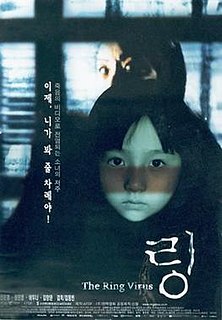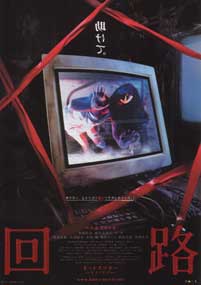
Magnetic tape is a medium for magnetic recording, made of a thin, magnetizable coating on a long, narrow strip of plastic film. It was developed in Germany in 1928, based on magnetic wire recording. Devices that record and play back audio and video using magnetic tape are tape recorders and video tape recorders respectively. A device that stores computer data on magnetic tape is known as a tape drive.

The Ring is a 2002 American supernatural horror film directed by Gore Verbinski and starring Naomi Watts, Martin Henderson, David Dorfman, and Brian Cox. It is a remake of the 1998 Japanese horror film Ring based on the novel of the same name by Koji Suzuki.

The common gull is a medium-sized gull that breeds in northern Asia, northern Europe, and northwestern North America. The North American subspecies is commonly referred to as the mew gull, although that name is also used by some authorities for the whole species. It migrates further south in winter. There are differing accounts as to how the species acquired its vernacular name.
Metafiction is a form of literature that emphasizes its own constructedness in a way that continually reminds the reader to be aware that they are reading or viewing a fictional work. Metafiction is self-conscious about language, literary form, storytelling, and directly or indirectly draw attention to their status as artifacts. Metafiction is frequently used as a form of parody or a tool to undermine literary conventions and explore the relationship between literature and reality, life, and art. Although metafiction is most commonly associated with postmodern literature, its use can be traced back to much earlier works of fiction, such as Geoffrey Chaucer's Canterbury Tales (1387), Miguel de Cervantes' Don Quixote (1605), William Shakespeare's Pericles, Prince of Tyre (c.1608), Laurence Sterne's The Life and Opinions of Tristram Shandy, Gentleman (1759), William Makepeace Thackeray's Vanity Fair (1847), as well as more recent works such as J.R.R. Tolkien's The Lord of the Rings (1954–1955), or Douglas Adams' The Hitchhiker's Guide to the Galaxy (1979). Metafiction, however, became particularly prominent in the 1960s, with authors and works such as John Barth's Lost in the Funhouse, Robert Coover's "The Babysitter" and "The Magic Poker", Kurt Vonnegut's Slaughterhouse-Five, John Fowles' The French Lieutenant's Woman, Thomas Pynchon's The Crying of Lot 49 and William H. Gass's Willie Master's Lonesome Wife.
Psychological horror is a subgenre of horror and psychological fiction that relies on mental, emotional and psychological states to frighten, disturb, or unsettle readers, viewers, or players. The subgenre frequently overlaps with the related subgenre of psychological thriller, and it often uses mystery elements and characters with unstable, unreliable, or disturbed psychological states to enhance the suspense, drama, action, and paranoia of the setting and plot and to provide an overall unpleasant, unsettling, or distressing atmosphere.

An audience is a group of people who participate in a show or encounter a work of art, literature, theatre, music, video games, or academics in any medium. Audience members participate in different ways in different kinds of art; some events invite overt audience participation and others allowing only modest clapping and criticism and reception.

The Ring Virus (Hangul: 링) is a South Korean horror film adapted from the Japanese novel Ring by Koji Suzuki. A joint project between Japan and Korea, this version has Park Eun-Suh as the creator of the cursed videotape. Although the filmmakers claimed that the film was adapted from the novel, there are various scenes in the film that match the 1998 film Ring, such as the sex of the lead character, some of the scenes on the videotape as well as copying other film scenes directly from the original film, including the film's climax.
Alexander R. Galloway (1974) is an author and professor in the Department of Media, Culture, and Communication at New York University. He has a bachelor's degree in Modern Culture and Media from Brown University, and a Ph.D. in Literature from Duke University in 2001. Galloway is known for his writings on philosophy, media theory, contemporary art, film, and video games.

Ghost hunting is the process of investigating locations that are reported to be haunted by ghosts. Typically, a ghost-hunting team will attempt to collect evidence supporting the existence of paranormal activity. Ghost hunters use a variety of electronic devices, including EMF meters, digital thermometers, both handheld and static digital video cameras, including thermographic and night vision cameras, as well as digital audio recorders. Other more traditional techniques are also used, such as conducting interviews and researching the history of allegedly haunted sites. Ghost hunters may also refer to themselves as "paranormal investigators."
McKenzie Wark is an Australian-born writer and scholar. Wark is known for their writings on media theory, critical theory, new media, and the Situationist International. Their best known works are A Hacker Manifesto and Gamer Theory. They are Professor of Media and Cultural Studies at The New School in New York City.
Speculative realism is a movement in contemporary Continental-inspired philosophy that defines itself loosely in its stance of metaphysical realism against the dominant forms of post-Kantian philosophy.
Supernatural horror film is a film genre that combines aspects of horror film and supernatural film. Supernatural occurrences in such films often include ghosts and demons, and many supernatural horror films have elements of religion. Common themes in the genre are the afterlife, the Devil, and demonic possession. Not all supernatural horror films focus on religion and can have "more vivid and gruesome violence".

Urban Gothic is a subgenre of Gothic fiction, film horror and television dealing with industrial and post-industrial urban society. It was pioneered in the mid-19th century in Britain, Ireland and the United States and developed in British novels such as Robert Louis Stevenson's Strange Case of Dr Jekyll and Mr Hyde (1886), and Irish novels such as Oscar Wilde's The Picture of Dorian Gray (1890), and Bram Stoker's Dracula (1897). In the twentieth century, urban Gothic influenced the creation of the subgenres of Southern Gothic and suburban Gothic. From the 1980s, interest in the urban Gothic revived with books like Anne Rice's Vampire Chronicles and a number of graphic novels that drew on dark city landscapes, leading to adaptations in film including Batman (1989), The Crow (1994) and From Hell (2001), as well as influencing films like Seven (1995).

Richard Thomas is an American author. His focus is on neo-noir fiction, typically including elements of violence, mental instability, breaks in reality, unreliable narrators, and tragedies. His work is rich in setting and sensory details—often called maximalism. It has also been called transgressive and grotesque. He was Editor-in-Chief at Dark House Press (2012-2016) and is currently Editor-in-Chief of Gamut Magazine.

Ring, also known as The Ring, is a Japanese horror media franchise, based on the novel series of the same name written by Koji Suzuki. The franchise includes eight Japanese films, two television series, six manga adaptations, five international film remakes, and a video game.













